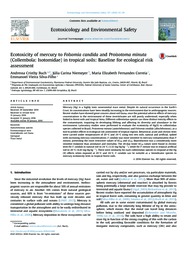Ecotoxicity of mercury to Folsomia candida and Proisotoma minuta (Collembola: isotomidae) in tropical soil: baseline for ecological risk assessment.
Ecotoxicity of mercury to Folsomia candida and Proisotoma minuta (Collembola: isotomidae) in tropical soil: baseline for ecological risk assessment.
Autoria: BUCH, A. C.; NIEMEYER, J. C.; CORREIA, M. E. F.; SILVA FILHO, E. V.
Resumo: Mercury (Hg) is a highly toxic nonessential trace metal. Despite its natural occurrence in the Earth's Crust, its concentrations have been steadily increasing in the environment due to anthropogenic sources. Recent studies have showed great concern about soil fauna, once the potential adverse effects of mercury concentrations in the environment of these invertebrates are still poorly understood, especially when linked to forest soils and tropical biota. Different collembolan species can show distinct toxicity effects to the contaminants, impairing its developing lifelong and affecting its diversity and abundance in the environment. Laboratory studies were performed to evaluate the ecotoxicity of Hg(II) to collembolan species collected in Brazil, Proisotoma minuta (autochthonous) and Folsomia candida (allochthonous), as a tool to predict effects in ecological risk assessment of tropical regions. Behavioral, acute and chronic tests were carried under temperatures of 20 °C and 24 °C using two test soils, natural and artificial, spiked with increasing mercury concentrations. F. candida was more sensitive to mercury contamination than P. minuta, presenting the most restrictive values of EC50 and LC50. Reproduction was a considerably more sensitive endpoint than avoidance and mortality. The 28-day lower EC50 values were found in chronic tests for F. candida in natural soil to 24 °C (3.32 mg Hg kg?1), while for P. minuta was in tropical artificial soil to 20 °C (4.43 mg Hg kg?1). There were similarity for each collembolan species to respond at the Hg(II) effects when exposed at 20 °C and 24 °C. F. candida can be suitable as a bioindicator species to mercury ecotoxicity tests in tropical forest soils.
Ano de publicação: 2016
Tipo de publicação: Artigo de periódico
Unidade: Embrapa Agrobiologia
Palavras-chave: Autochthonous species, Ecotoxicological tests, Invertebrates soil fauna, Springtail, Trace metal
Observações
1 - Por padrão são exibidas publicações dos últimos 20 anos. Para encontrar publicações mais antigas, configure o filtro ano de publicação, colocando o ano a partir do qual você deseja encontrar publicações. O filtro está na coluna da esquerda na busca acima.
2 - Para ler algumas publicações da Embrapa (apenas as que estão em formato ePub), é necessário ter, no celular ou computador, um desses softwares gratuitos. Sistemas Android: Google Play Livros; IOS: iBooks; Windows e Linux: software Calibre.
Acesse outras publicações
Acesse a Base de Dados da Pesquisa Agropecuária (BDPA) para consultar o acervo completo das bibliotecas da Embrapa.

